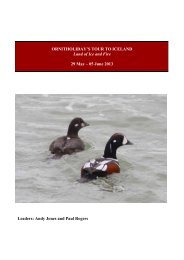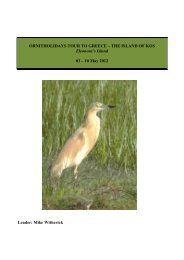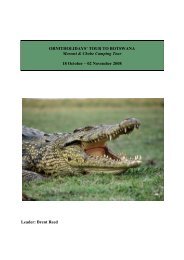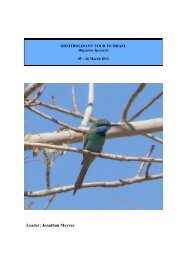Download 2014 Brochure (.pdf) - Ornitholidays
Download 2014 Brochure (.pdf) - Ornitholidays
Download 2014 Brochure (.pdf) - Ornitholidays
Create successful ePaper yourself
Turn your PDF publications into a flip-book with our unique Google optimized e-Paper software.
M E X I C O<br />
Mexico<br />
Western Mexican Endemics<br />
Friday 17 January – Monday 27 January <strong>2014</strong><br />
Leaders: Colin Bushell and local guides<br />
<strong>2014</strong> Cost: £3,499 single room supplement £240<br />
Puerto Vallarta<br />
MEXICO<br />
San Blas<br />
Friday 23 January – Monday 02 February 2015<br />
Leaders: Colin Bushell and local guides<br />
2015 Cost: £3,599 single room supplement £250<br />
Mexico City<br />
he small Mexican west coast fishing town of San Blas, once the scene of almost total devastation after Hurricane Kenna in 2002, is rightly famous<br />
T as a top class birding destination. Recovery from one of the strongest hurricanes ever to hit the Pacific coast of Mexico has been both swift and<br />
impressive (the entire town was virtually in ruins) and thankfully the local bird populations, apart from a few species, remain intact too. With a variety of<br />
Mexican habitats close at hand, ranging from open ocean, mangrove swamps, tropical dry and semi-deciduous forests to pine-oak woodlands in the<br />
nearby mountains, San Blas is a perfect base for a birding tour to Western Mexico. Within this suite of habitats we can hope to find many interesting<br />
species such as Collared Forest-Falcon, Bare-throated Tiger-Heron, Northern Potoo, Russet-crowned Motmot and White-striped Woodcreeper. Around<br />
thirty Mexican endemic bird species can be found in the environs of San Blas, some within walking distance of our hotel which, by the way, is<br />
accustomed to birding groups and of a very comfortable standard. Whilst many of the tropical birds (at their northernmost limit here in San Blas) will<br />
be of utmost importance, we will not be ignoring the plethora of migrants that spend their winter in the dry thorn forests, coffee fincas, coastal lagoons<br />
and beaches in the area. The beauty of all this is that most birding sites are only a short distance from San Blas that holds records for number of species<br />
seen for Christmas Bird Counts and "Big Day" totals. We have also included a short pelagic to see whales and dolphins. Travel with Colin, on our<br />
second and third tours to San Blas, and see why this tour to this small area of Mexico is such a great addition to the <strong>Ornitholidays</strong>’ suite of holidays.<br />
ITINERARY<br />
Day 1<br />
We leave London in the morning on a flight to<br />
Mexico City, arriving later the same day. We transfer<br />
to a hotel near the airport where we stay overnight.<br />
Days 2 to 9<br />
We return to the airport for our early morning flight<br />
to Puerto Vallarta, where we enjoy a three hour<br />
boat trip in Banderas Bay looking for Humpback<br />
Whales, plus Bottle-nosed, Spinner and Spotted<br />
Dolphins. Our agents here have been studying<br />
the whales since 1996 and are founder members<br />
of a conservation group dedicated to research,<br />
conservation and protection of these<br />
Humpbacks. Our guide will explain the behaviour<br />
of these magnificent creatures as we watch them<br />
breach, slap their tails, travel or play or fight. We<br />
return to Puerto Vallarta for lunch before travelling<br />
to our hotel in San Blas where we stay for the<br />
remainder of the tour.<br />
During our stay in the state of Nayarit at San Blas<br />
we will have many birding options available to<br />
us, mostly within a short distance of San Blas.<br />
Typical birds close at hand include Common<br />
Black-Hawk, Mexican Parrotlet, Citreoline<br />
Trogon, Golden-cheeked Woodpecker, Sinaloa<br />
Crow, Black-throated Magpie-Jay, San Blas Jay,<br />
Happy Wren, Yellow-winged Cacique and<br />
Rufous-backed Thrush.<br />
The San Blas area is dotted with lagoons and<br />
pools allowing us to take a break from birding<br />
the forest and arid scrub. At this time of year we<br />
should see a variety of shorebirds having arrived<br />
from the north and spending the winter on the<br />
Pacific coast of Mexico. Great Blue and<br />
Tricolored Herons, Reddish Egret, Limpkin,<br />
Wood Stork, Roseate Spoonbill, Northern<br />
Jacana, Semipalmated Plover, Black-necked<br />
Stilt, Marbled Godwit, Western and Least<br />
Sandpipers and Long-billed Dowitcher can all be<br />
expected at this time of year. Blue-winged Teal<br />
loaf around on islands in the lagoons while Ringnecked<br />
Duck and Lesser Scaup can be found in<br />
the deeper channels.<br />
Weedy fields and scrubby woodland patches are<br />
worthy of inspection around town (especially if<br />
there are any fruiting trees) with Rufous-bellied<br />
Chachalaca, Elegant Quail, Russet-crowned<br />
Motmot, Lineated Woodpecker, Purplish-backed<br />
Jay, Happy Wren, Yellow-breasted Chat, Rosy<br />
Thrush-Tanager and Painted Buntings all possible.<br />
Russet-crowned Motmot<br />
By way of a change we have the opportunity to<br />
explore the nearby mangrove forests by boat.<br />
Bare-throated Tiger-Heron, Boat-billed Heron,<br />
Muscovy Duck and two species of whistlingducks<br />
should be seen as we coast quietly along<br />
the channels watching out for crocodiles as we<br />
go. Raptors here include Great and Common<br />
Black-Hawks as well as Crane Hawk and<br />
Laughing Falcon. Collared Forest-Falcons can<br />
even be seen here as well. By mooring in a likely<br />
spot we may be able to lure Mangrove (Yellow)<br />
Warblers into view by imitating the rather<br />
monotonous call of a Ferruginous Pygmy-Owl (a<br />
species that may also appear of course).<br />
Patience and diligence will be required to find<br />
the "San Blas Mangrove Specialities" - the<br />
Rufous-necked Wood-Rail or Mangrove Cuckoo<br />
however. We will make sure that one of our<br />
mangrove trips is in the evening so that we may<br />
do a bit of spotlighting as Northern Potoo<br />
appears at dusk. This strange nocturnal species<br />
can often be found on a stump in the middle of<br />
the mangroves, easily located by its "eye shine"<br />
in the beam of the lamp. Pauraque and maybe<br />
Mottled Owl can be seen on an evening trip too.<br />
Another boat trip takes us offshore with Brown<br />
Pelicans and many Magnificent Frigatebirds for<br />
company as we make our way out of the mouth<br />
of the Estero in search of Brown and Blue-footed<br />
Boobies. The rocky shores are a good place to<br />
find Yellow-crowned Night-Herons and the<br />
handsome Heermann's Gull should be located<br />
with Ring-billed Gulls on the beaches.<br />
A couple of short excursions take us to the wellknown<br />
birding sites of Singayta and La Bajada.<br />
Scrub with marshland and tropical palm and<br />
semi-deciduous forest-covered hillsides<br />
dominates, with coffee plantations providing<br />
extra cover lower down. The marsh at Singayta is<br />
a good site for White-throated Flycatcher that<br />
winters here in some numbers, but Willow and<br />
Least Flycatchers are also present so prepare for<br />
an identification headache! Open fields should<br />
be checked for Stripe-headed Sparrows and the<br />
sky checked for raptors such as Hook-billed Kite<br />
and Crane and Zone-tailed Hawks before<br />
22<br />
For a previous tour report or further information please call: 01794 519445








